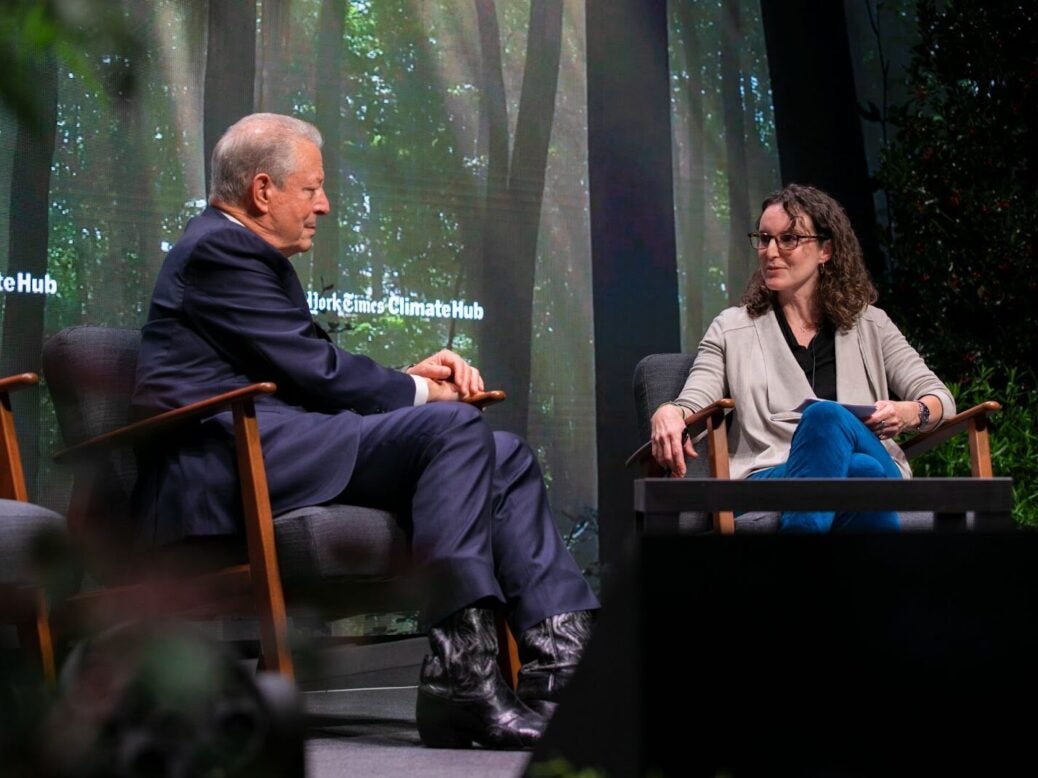
The climate editor at The New York Times believes that even when you’re trying to save the world, some journalistic competition is a good thing.
Hannah Fairfield (pictured right, with Al Gore), told Press Gazette why the paper is mixing live events into its climate coverage and how that works financially.
And she explained how she went from leading the Times’ graphics work to its climate change coverage five years ago.
New York Times ‘Climate Hub’
For ten days last year The New York Times hosted a “Climate Hub” at the COP26 UN climate conference in Glasgow, holding more than 70 events including film screenings, speeches, panels and performances.

The Conference of the Trees, an installation by Es Devlin, at The New York Times Climate Hub in Glasgow. Picture: Craig Gibson for The New York Times
Events have become a theme: following an inaugural three-day “Climate Forward Conversations” event in London earlier this year, another two such “conversations” series are due in New York on 20 September and Sharm el Sheikh in November for COP27.
Why is the NYT going to far-off cities to run events about climate?
“Our events seek to expose tensions in the climate debate and bring diverse perspectives to the stage,” Fairfield told Press Gazette in an email interview.
“The engaging conversations, serendipitous encounters and curated performance space at our ten-day Climate Hub last year was an example of the alchemy The New York Times can create to engage with new communities.”
Today: New York Times Climate Hub @nytclimate #COP26 pic.twitter.com/59F6RTanEW
— Henry Hepburn (@Henry_Hepburn) November 5, 2021
Unlike some of The New York Times’ other recent experiments, the climate events aren’t a bid for revenue – although sponsorships help fund their production.
[Read more: Oscars, CGI and Jonathan Pie – Inside The New York Times’ award-winning Opinion Video department]
“The purpose of our climate events is to bring readers closer to our climate reporting,” said Fairfield.
“Our sponsors help to fund the production of our events, which are curated to a high standard and broadcast live online to reach readers around the world.”
In Glasgow, those sponsors included Siemens Energy and Morgan Stanley; the new events are funded by the latter corporation alongside Google.
“As journalists, it’s our role to help explain the abstraction of climate science in the pages of our report through storytelling and the theatre of live events.”
https://twitter.com/Nicolette_mck/status/1459204730434068480
From editing graphics to editing climate
Before taking over the paper’s climate beat in 2017, Fairfield was its graphics editor in a role in which, she said, she had “great fortune to work on a lot of amazing climate and environment stories”.
The journalist, who holds degrees in geoscience and environmental science, added that graphics “hold so much visual and explanatory power.
“I really wanted to help people understand the world around them, and how it is changing. When the opportunity to lead a new desk at The New York Times opened up, I raised my hand for it because it seemed like the perfect combination of science, policy and visual storytelling.
“And I was lucky that the newsroom leadership wanted to give me a chance to build a desk with a strong emphasis on visuals.”
The fruits of this effort have included recent features on a “megastorm” due to hit California and the weather systems created by wildfires.
Fairfield said “more than five years in, I’m even more optimistic than I was when we began… climate stories are everywhere, and readers are eager for them.”
Like the planet, competition is hotting up
The New York Times isn’t the only publication to have invested in its climate coverage in recent years.
The Washington Post has hired journalists specifically for climate coverage. The UK’s Daily Express under editor Gary Jones has sought to appeal to an untapped appetite among conservative readers for environmental conservation. And Sky News introduced a daily climate show for COP26 – although it has since moved the programme to weekends.
Given the nature of the subject, one might assume all coverage is good. But did Fairfield and her reporters still have a traditional sense of competition for stories with their peers?
“Old-fashioned journalistic competition is a great incentive to do great work.
“Yes, we absolutely like to get scoops, like a recent one from Lisa Friedman on Biden appointing [former Bill Clinton Chief of Staff] John Podesta to be his new domestic climate leader.
“And when other news organisations get scoops, we congratulate them, and then we work harder.”
Fairfield noted that it wasn’t just at the Times that reporting had become more visual, citing Vox‘s “gorgeous piece on supertrees and climate” and The Washington Post’s “stunning” article on California wildfires.
“When other news organisations hire more reporters to cover climate issues, I celebrate because it means that we — and by we, I mean climate journalists — are changing newsrooms and having an impact.”
Picture: Craig Gibson for The New York Times
Email pged@pressgazette.co.uk to point out mistakes, provide story tips or send in a letter for publication on our "Letters Page" blog
